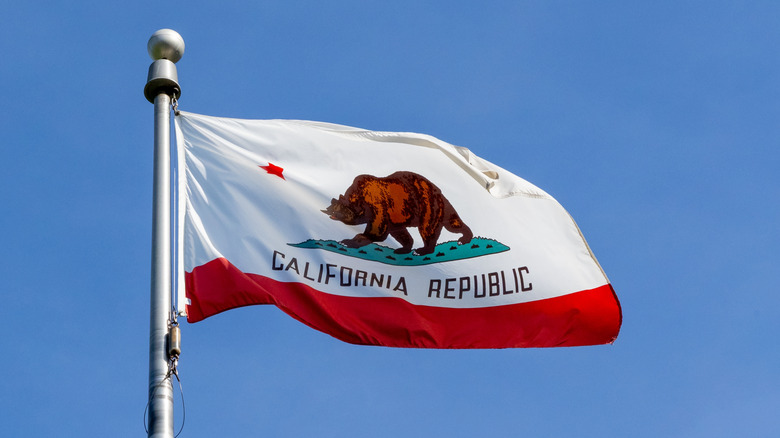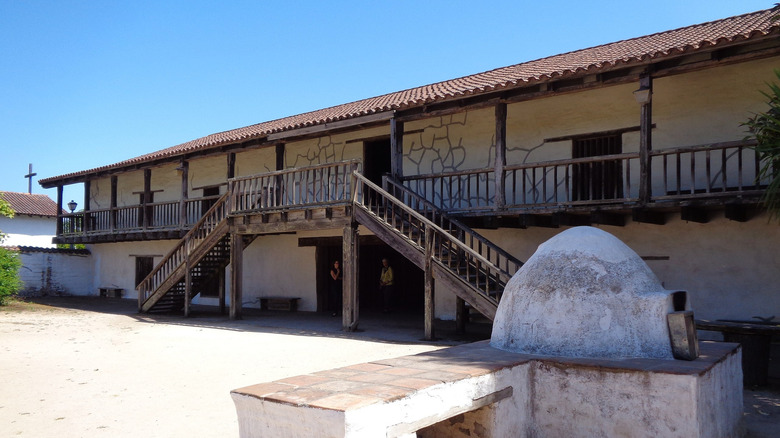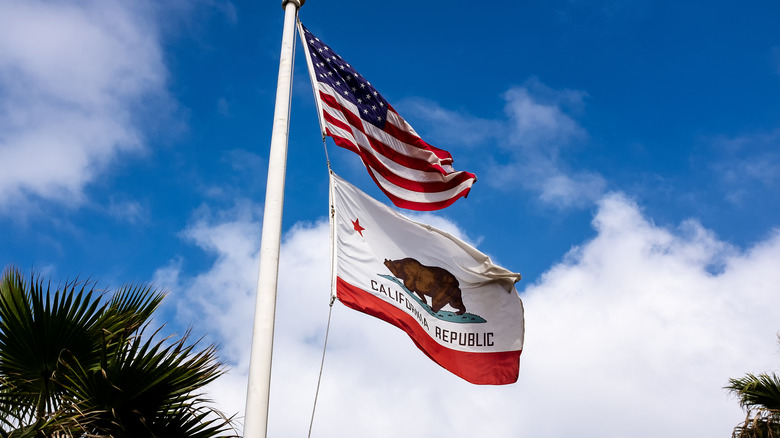What Does The California State Flag Mean?
"California." What are some things that come to mind when you hear that state's name? Sunny beaches blanketed by supremely tanned bodies? The glitz and glamour of Hollywood celebrities? Vineyards, gold rushes, and terrible forest fires? Maybe the Redwood trees near San Francisco or the Baja-influenced San Diego? Or if you're realistic about things, maybe you imagine the state's nightmarishly packed highway system. But you know what you probably didn't think about? Bears. Bears walking on grass with a red star in the sky and a red band along the bottom. What's up with California's state flag, anyway?
The first clue about California's state flag doesn't come from the bear, the grass, the star, or the red band — it comes from the word "Republic." Long before California featured gated Beverly Hills communities a short drive from Skid Row it was a part of Mexico. In what became a chain of conflicts for independence, Mexico won its freedom from Spain in 1821. Then, California revolved against Mexico in the middle of the Mexican-American War (1846 to 1848) after the U.S. annexed Texas.
Western Colorado along with the territories of California, New Mexico, Utah, and Nevada got bundled into a $15 million purchase that ended the war in favor of the U.S., but not before California declared itself an independent nation in 1846, the California Republic. This lasted 25 days. But, it wasn't even Mexicans who declared California independent. It was a group of American settlers who took Sonoma with guns and by force. The whole incident was called the Bear Flag Revolt.
Bears on flags and the Bear Flag Revolt
So yes, California's flag rose in the Bear Flag Revolt during the state's tangled origins as a Mexican territory. After war broke out between the United States and Mexico in 1846, a group of American settlers in California claimed that the Mexican government had been "oppressive, tyrannical, and despotic," as the California Frontier Project explains. They entered the home of General Mariano Guadalupe Vallejo in Sonoma, tore down the Mexican flag, raised their own hand-made one, and said, "We're our country now." Either because they were ragtag, or because they chose a bear for their flag, they were dubbed "Los Osos" — the bears. In this way, no matter what they chose to put on the Californian flag, the flag means this sentiment of rugged rebelliousness.
Los Osos' flag wasn't too different from the modern-day Californian flag. It featured a solid-color star and bear of about equal sizes in the upper-middlish part of the flag. The star was light brown and the bear red. Under the star and bear were the words we see today: "California Republic." The red stripe was there on the bottom, too. After California became a state in 1850, it remained without a flag for over 60 years. But, thanks to citizen advocacy it wound up using Los Osos' design anyway. California got its rearranged, stylized bear flag in 1911, along with a newer-looking bear in 1953. But all such changes were ultimately cosmetic, as the flag's meaning related to the Bear Flag Revolt never changed.
'An emblem of strength and unyielding resistance'
You could do far worse for a flag animal than a bear. Los Osos must have thought the same because as the California Pioneer Heritage Society says, they chose the bear for their flag as "an emblem of strength and unyielding resistance." They didn't choose just any bear, mind you, like those backyard racoons-in-disguise, black bears. They chose grizzly bears because a specific subspecies of grizzly used to inhabit California: Ursus arctos californicus. The final Californian grizzly was killed in Yosemite in the wild in 1895, per the National Park Service. But by then Californians had already seen their first grizzly in a zoo, named "Monarch," in 1889. It's Monarch who made his way onto California's 1911 flag design, grass and all. And, the now-extinct California grizzly is still California's state animal.
As for the meaning of the other elements on the California flag, we've only got two items to choose from: the star and the red band on the bottom. Los Osos borrowed the solo star from Texas, the Lone Star State, as they took inspiration from Texas' rebelliousness, which kicked off the Mexican-American war. Also, a single star does make sense for a new, breakaway nation. As for the stripe on the bottom, it was meant to imitate the U.S. flag. Fast forward to California's first official 1911 flag as a U.S. state, and legislators chose to keep the star and stripe as echoes of the national flag. And so we end up with the modern-day Californian flag.


